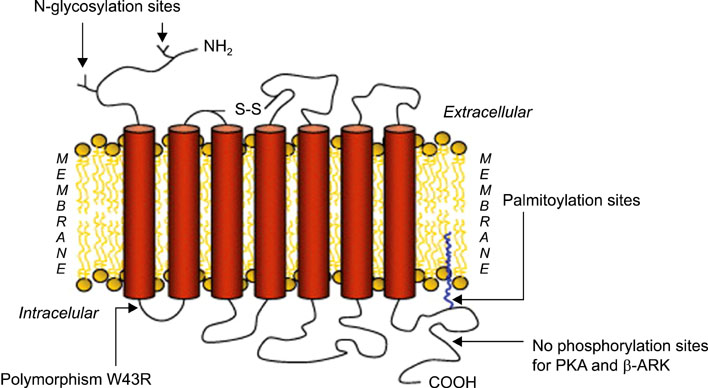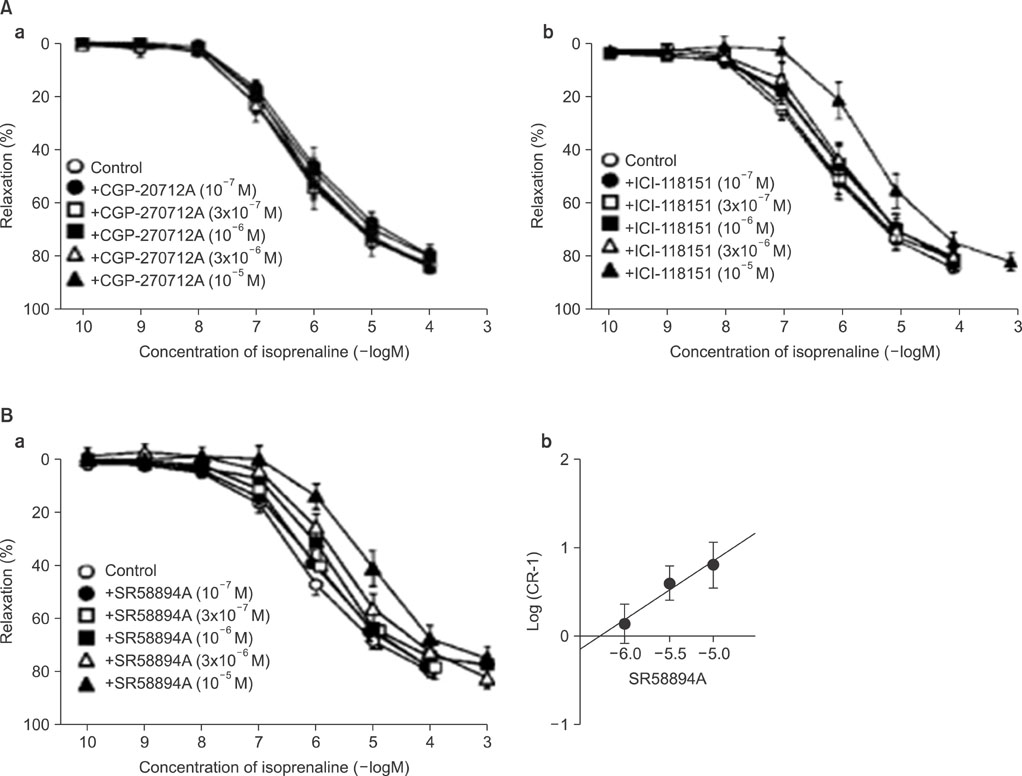Korean J Urol.
2010 Dec;51(12):811-818.
Beta3-Adrenoceptor Agonists: Possible Role in the Treatment of Overactive Bladder
- Affiliations
-
- 1Department of Continence Medicine, University of Tokyo Graduate School of Medicine, Tokyo, Japan. yigawa-jua@umin.ac.jp
- 2Department of Urology, University of Tokyo Graduate School of Medicine, Tokyo, Japan.
Abstract
- In the present review article, we present an overview of beta-adrenoceptor (beta-AR) subtype expression at the mRNA and receptor protein levels in the human detrusor, the in vitro and in vivo bladder function of the beta3-AR, the in vivo effect of beta3-AR agonists on detrusor overactivity in animal models, and the available results of clinical trials of beta3-AR agonists for treating overactive bladder (OAB). There is a predominant expression of beta3-AR mRNA in human bladder, constituting 97% of total beta-AR mRNA. Also, functionally, the relaxant response of human detrusor to catecholamines is mainly mediated through the beta3-ARs. Moreover, the presence of beta1-, beta2-, and beta3-AR mRNAs in the urothelium and suburothelial layer of human bladder has been identified. Stimulation of urothelial beta-ARs results in the release of nitric oxide and an unknown substance inhibiting detrusor contractions from the urothelium. Intravenous application of CL316,243, a selective beta3-AR agonist, in rats selectively inhibits mechano-sensitive Adelta-fiber activity of the primary bladder afferents. A number of selective beta3-AR agonists are currently being evaluated in clinical trials for OAB with promising preliminary results. In conclusion, the beta3-AR agonists are the most notable alternative class of agents to antimuscarinics in the pharmacological treatment of OAB. The beta3-AR agonists act to facilitate bladder storage function probably through at least two mechanisms: first, direct inhibition of the detrusor, and second, inhibition of bladder afferent neurotransduction.
MeSH Terms
Figure
Reference
-
1. Lands AM, Arnold A, McAuliff JP, Luduena FP, Brown TG Jr. Differentiation of receptor systems activated by sympathomimetic amines. Nature. 1967. 214:597–598.2. Ursino MG, Vasina V, Raschi E, Crema F, De Ponti F. The beta3-adrenoceptor as a therapeutic target: current perspectives. Pharmacol Res. 2009. 59:221–234.3. Emorine LJ, Marullo S, Briend-Sutren MM, Patey G, Tate K, Delavier-Klutchko C, et al. Molecular characterization of the human beta 3-adrenergic receptor. Science. 1989. 245:1118–1121.4. Nergårdh A, Boréus LO, Naglo AS. Characterization of the adrenergic beta-receptor in the urinary bladder of man and cat. Acta Pharmacol Toxicol. 1977. 40:14–21.5. Larsen JJ. Alpha and beta-adrenoceptors in the detrusor muscle and bladder base of the pig and beta-adrenoceptors in the detrusor muscle of man. Br J Pharmacol. 1979. 65:215–222.6. Morita T, Iizuka H, Iwata T, Kondo S. Function and distribution of beta3-adrenoceptors in rat, rabbit and human urinary bladder and external urethral sphincter. J Smooth Muscle Res. 2000. 36:21–32.7. Oshita M, Hiraoka Y, Watanabe Y. Characterization of beta-adrenoceptors in urinary bladder: comparison between rat and rabbit. Br J Pharmacol. 1997. 122:1720–1724.8. Yamazaki Y, Takeda H, Akahane M, Igawa Y, Nishizawa O, Ajisawa Y. Species differences in the distribution of beta-adrenoceptor subtypes in bladder smooth muscle. Br J Pharmacol. 1998. 124:593–599.9. Longhurst PA, Levendusky M. Pharmacological characterization of beta-adrenoceptors mediating relaxation of the rat urinary bladder in vitro. Br J Pharmacol. 1999. 127:1744–1750.10. Takeda H, Matsuzawa A, Igawa Y, Yamazaki Y, Kaidoh K, Akahane S, et al. Functional characterization of beta-adrenoceptor subtypes in the canine and rat lower urinary tract. J Urol. 2003. 170:654–658.11. Yamanishi T, Chapple CR, Yasuda K, Yoshida K, Chess-Williams R. The role of beta(3)-adrenoceptors in mediating relaxation of porcine detrusor muscle. Br J Pharmacol. 2002. 135:129–134.12. Strosberg AD. Structure and function of the beta 3-adrenergic receptor. Annu Rev Pharmacol Toxicol. 1997. 37:421–450.13. Strosberg AD, Pietri-Rouxel F. Function and regulation of the beta 3-adrenoceptor. Trends Pharmacol Sci. 1996. 17:373–381.14. Igawa Y, Yamazaki Y, Takeda H, Hayakawa K, Akahane M, Ajisawa Y, et al. Functional and molecular biological evidence for a possible beta3-adrenoceptor in the human detrusor muscle. Br J Pharmacol. 1999. 126:819–825.15. Fujimura K, Tamura K, Tsutsumi T, Yamamoto T, Nakamura K, Koibuchi Y, et al. Expression and possible functional role of the beta3-adrenoceptor in human and rat detrusor muscle. J Urol. 1999. 161:680–685.16. Takeda M, Obara K, Mizusawa T, Tomita Y, Arai K, Tsutsui T, et al. Evidence for beta3-adrenoceptor subtypes in relaxation of the human urinary bladder detrusor: analysis by molecular biological and pharmacological methods. J Pharmacol Exp Ther. 1999. 288:1367–1373.17. Nomiya M, Yamaguchi O. A quantitative analysis of mRNA expression of alpha 1 and beta-adrenoceptor subtypes and their functional roles in human normal and obstructed bladders. J Urol. 2003. 170:649–653.18. Yamaguchi O, Chapple CR. Beta3-adrenoceptors in urinary bladder. Neurourol Urodyn. 2007. 26:752–756.19. Michel MC, Vrydag W. Alpha1-, alpha2- and beta-adrenoceptors in the urinary bladder, urethra and prostate. Br J Pharmacol. 2006. 147:Suppl 2. S88–S119.20. Vrydag W, Michel MC. Tools to study beta3-adrenoceptors. Naunyn Schmiedebergs Arch Pharmacol. 2007. 374:385–398.21. Igawa Y, Yamazaki Y, Takeda H, Akahane M, Ajisawa Y, Yoneyama T, et al. Possible beta 3-adrenoceptor-mediated relaxation of the human detrusor. Acta Physiol Scand. 1998. 164:117–118.22. Igawa Y, Yamazaki Y, Takeda H, Kaidoh K, Akahane M, Ajisawa Y, et al. Relaxant effects of isoproterenol and selective beta3-adrenoceptor agonists on normal, low compliant and hyperreflexic human bladders. J Urol. 2001. 165:240–244.23. Takeda H, Yamazaki Y, Akahane M, Igawa Y, Ajisawa Y, Nishizawa O. Role of the beta(3)-adrenoceptor in urine storage in the rat: comparison between the selective beta(3)-adrenoceptor agonist, CL316, 243,and various smooth muscle relaxants. J Pharmacol Exp Ther. 2000. 293:939–945.24. Kaidoh K, Igawa Y, Takeda H, Yamazaki Y, Akahane S, Miyata H, et al. Effects of selective beta2 and beta3-adrenoceptor agonists on detrusor hyperreflexia in conscious cerebral infarcted rats. J Urol. 2002. 168:1247–1252.25. Woods M, Carson N, Norton NW, Sheldon JH, Argentieri TM. Efficacy of the beta3-adrenergic receptor agonist CL-316243 on experimental bladder hyperreflexia and detrusor instability in the rat. J Urol. 2001. 166:1142–1147.26. Takeda H, Yamazaki Y, Igawa Y, Kaidoh K, Akahane S, Miyata H, et al. Effects of beta(3)-adrenoceptor stimulation on prostaglandin E(2)-induced bladder hyperactivity and on the cardiovascular system in conscious rats. Neurourol Urodyn. 2002. 21:558–565.27. Leon LA, Hoffman BE, Gardner SD, Laping NJ, Evans C, Lashinger ES, et al. Effects of the beta 3-adrenergic receptor agonist disodium 5-[(2R)-2-[[(2R)-2-(3-chlorophenyl)-2-hydroxyethyl]amino] propyl]-1,3-benzodioxole-2,2-dicarboxylate (CL-316243) on bladder micturition reflex in spontaneously hypertensive rats. J Pharmacol Exp Ther. 2008. 326:178–185.28. Igawa Y. Discussion: functional role of M(1), M(2), and M(3) muscarinic receptors in overactive bladder. Urology. 2000. 55:5A Suppl. 47–49.29. Ehlert FJ, Ahn S, Pak KJ, Park GJ, Sangnil MS, Tran JA, et al. Neuronally released acetylcholine acts on the M2 muscarinic receptor to oppose the relaxant effect of isoproterenol on cholinergic contractions in mouse urinary bladder. J Pharmacol Exp Ther. 2007. 322:631–637.30. Takasu T, Ukai M, Sato S, Matsui T, Nagase I, Maruyama T, et al. Effect of (R)-2-(2-aminothiazol-4-yl)-4'-{2-[(2-hydroxy-2-phenylethyl) amino]ethyl} acetanilide (YM178), a novel selective beta3-adrenoceptor agonist, on bladder function. J Pharmacol Exp Ther. 2007. 321:642–647.31. Uchida H, Shishido K, Nomiya M, Yamaguchi O. Involvement of cyclic AMP-dependent and -independent mechanisms in the relaxation of rat detrusor muscle via beta-adrenoceptors. Eur J Pharmacol. 2005. 518:195–202.32. Frazier EP, Mathy MJ, Peters SL, Michel MC. Does cyclic AMP mediate rat urinary bladder relaxation by isoproterenol? J Pharmacol Exp Ther. 2005. 313:260–267.33. Otsuka A, Shinbo H, Matsumoto R, Kurita Y, Ozono S. Expression and functional role of beta-adrenoceptors in the human urinary bladder urothelium. Naunyn Schmiedebergs Arch Pharmacol. 2008. 377:473–481.34. Birder LA, Nealen ML, Kiss S, de Groat WC, Caterina MJ, Wang E, et al. Beta-adrenoceptor agonists stimulate endothelial nitric oxide synthase in rat urinary bladder urothelial cells. J Neurosci. 2002. 22:8063–8070.35. Murakami S, Chapple CR, Akino H, Sellers DJ, Chess-Williams R. The role of the urothelium in mediating bladder responses to isoprenaline. BJU Int. 2007. 99:669–673.36. Masunaga K, Chapple CR, McKay NG, Yoshida M, Sellers DJ. The β3-adrenoceptor mediates the inhibitory effects of β-adrenoceptor agonists via the urothelium in pig bladder dome. Neurourol Urodyn. 2010. 29:1320–1325.37. Otsuka A, Matsumoto R, Shinbo H, Imanishi T, Kurita Y, Ozono S. Distribution of beta-adrenoceptor subtypes in suburothelial interstitial cells in the human urinary bladder. Neurourol Urodyn. 2009. 28:Suppl. 871–872. abstract 225.38. Limberg BJ, Andersson KE, Aura Kullmann F, Burmer G, de Groat WC, Rosenbaum JS. β-adrenergic receptor subtype expression in myocyte and non-myocyte cells in human female bladder. Cell Tissue Res. 2010. 342:295–306.39. Aizawa N, Igawa Y, Nishizawa O, Wyndaele JJ. Effects of CL316,243, a beta 3-adrenoceptor agonist, and intravesical prostaglandin E2 on the primary bladder afferent activity of the rat. Neurourol Urodyn. 2010. 29:771–776.40. Arch JR, Ainsworth AT, Cawthorne MA, Piercy V, Sennitt MV, Thody VE, et al. Atypical beta-adrenoceptor on brown adipocytes as a target for anti-obesity drugs. Nature. 1984. 309:163–165.41. Dolan JA, Muenkel HA, Burns MG, Pellegrino SM, Fraser CM, Pietri F, et al. Beta-3 adrenoceptor selectivity of the dioxolane dicarboxylate phenethanolamines. J Pharmacol Exp Ther. 1994. 269:1000–1006.42. Michel MC, Ochodnicky P, Summers RJ. Tissue functions mediated by beta(3)-adrenoceptors-findings and challenges. Naunyn Schmiedebergs Arch Pharmacol. 2010. 382:103–108.43. Hu B, Jennings LL. Orally bioavailable beta 3-adrenergic receptor agonists as potential therapeutic agents for obesity and type-II diabetes. Prog Med Chem. 2003. 41:167–194.44. Hicks A, McCafferty GP, Riedel E, Aiyar N, Pullen M, Evans C, et al. GW427353 (solabegron), a novel, selective beta3-adrenergic receptor agonist, evokes bladder relaxation and increases micturition reflex threshold in the dog. J Pharmacol Exp Ther. 2007. 323:202–209.45. Biers SM, Reynard JM, Brading AF. The effects of a new selective beta3-adrenoceptor agonist (GW427353) on spontaneous activity and detrusor relaxation in human bladder. BJU Int. 2006. 98:1310–1314.47. Chapple CR, Yamaguchi O, Ridder A, Liehne J, Carl S, Mattiasson A, et al. Clinical proof of concept study (Blossom) shows novel β3 adrenoceptor agonist YM178 is effective and well tolerated in the treatment of symptoms of overactive bladder. Eur Urol. 2008. Suppl 7. 239.48. Chapple C, Wyndaele JJ, van Kerrebroeck P, Radziszewski P, Dvorak V, Boerrigter P. Dose-ranging study of once-daily mirabegron (YM178), a novel selective β3-adrenoceptor agonist, in patients with overactive bladder (OAB). Eur Urol. 2010. Suppl 9. 249.
- Full Text Links
- Actions
-
Cited
- CITED
-
- Close
- Share
- Similar articles
-
- Persistence and compliance with medication management in the treatment of overactive bladder
- Inhibitory Effect and Possible Mechanism of Intraurethral Stimulation on Overactive Bladder in Female Rats
- Drug therapy of overactive bladder - What is coming next?
- On the Site and Mechanism of Action of β₃-Adrenoceptor Agonists in the Bladder
- Clinical applications of alpha2 adrenoceptor agonist




